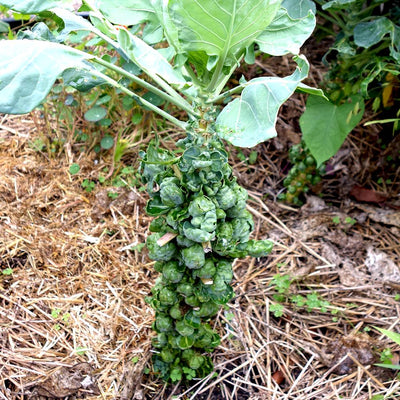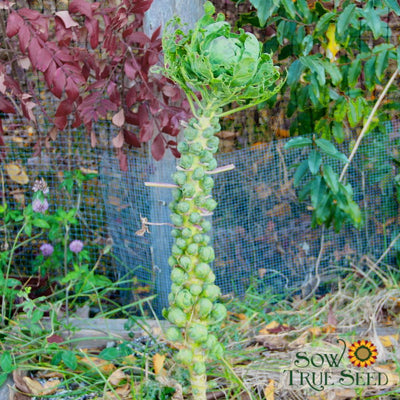How to Grow Brussels Sprouts In Your Home Garden

About Brussels Sprouts
If you’ve had brussels sprouts since you were a kid, you probably love them now. If you haven’t, you’re missing out on one of the best, most underrated vegetables out there. We recommend you give them a try.
Brussels sprouts were named for Brussels, Belgium, which is where they were first grown as far back as the 16th century. Brussels sprouts are in the Brassica family which means they’re the same species as other garden favorites including cabbage, broccoli, kale, and cauliflower.
This delicious vegetable, while easy and rewarding to cook, can be a little finicky to grow due mainly to their long growing season which is between 80 and 100 days depending on the variety. But don’t lose hope yet! With a little guidance and patience, you too can grow this rewarding crop.
Recommended Brussels Sprout Varieties

Catskill Brussels Sprouts - This highly productive dwarf heirloom was introduced in 1941 by Arthur White of Arkport, NY. It has become a prized favorite for its large, two-inch diameter, super-flavorful sprouts produced on compact, sturdy plants. For Southern growers, Catskill brussels sprouts do best when started indoors in mid-to-late summer, then transplanted out as temperatures cool off in early fall. Northern growers can also start them in early spring. Sprouts begin maturing about 80 days after transplanting.

Long Island Improved Brussels Sprouts - This reliable, heavy-yielding heirloom has been a favorite since its introduction in the late 1800s. Compact, 20-inch tall plants produce 50 to 100 large, tightly headed, dark green sprouts per stalk. For Southern gardeners, Long Island Improved brussels sprouts will do best when started indoors in mid-to-late summer, then transplanted out as temperatures cool off in early fall. Northern growers can also start them in early spring. Sprouts begin maturing about 80 days after transplanting.
Planting Brussels Sprouts
The best way to grow brussels sprouts depends somewhat on where you live. These plants need a long growing season and mature best in cool temperatures. In most climates you’ll want to sow the seed in spring, planning for a fall harvest. In areas with long, cool summers, you can sow your seeds in early spring or midsummer for fall! The key with brussels sprouts is letting them end the season and mature under cool temperatures.
How to Grow Brussels Sprouts From Seed
Because of this crop's long growing season it is recommended in most – if not all – cases to start your seeds indoors. This can give these finicky crops a head start and a chance to mature before facing the trials and tribulations of the garden for the long season ahead.
Brussels sprouts will germinate well in cool temperatures as low as 45 degrees Fahrenheit. Providing seedlings with even moisture and plenty of light will help them mature healthily and avoid legginess.
When to Plant Brussels Sprouts
Brussels sprouts should be started from seed about four to eight weeks before the last frost in spring and transplanted out in early summer, about 60-80 days before the first fall frost. In warmer growing zones (8 and up), plants started in late summer can be put out into the garden in the fall and grown as a winter to spring crop. The brussels sprouts themselves get sweeter with a few light frosts in the fall so letting them mature throughout the cooler temperatures can provide you with an even better crop at harvest time.
Where to Plant Brussels Sprouts
Your planting site should get at least eight hours of direct sunlight per day. Soil should be extremely rich in nutrients and well draining. In the weeks leading up to planting, it’s worthwhile to spend time amending your soil with compost, organic matter, greensand if clay is an issue and more. Soil quality can be the defining factor for success with brussels sprouts.
How to Plant Brussels Sprouts
When starting seeds indoors, sow three seeds per pot or cell about a quarter inch deep and water well. When seedlings have four leaves, thin to one plant per pot and keep your grow lights close to the top of your plants, moving them up as the plants grow.
Begin hardening off your seedlings four weeks before you’re ready to plant them out. This long, slow process is beneficial for their long term health. Start with just an hour or two on the first day, bringing them in at night. Slowly extend this time until they’re spending eight to ten hours outside.
In your chosen planting area, spread two to three inches of compost and fork your soil to aerate it. Plant your seedlings out at 18 to 24 inches apart. Covering plants with floating row cover will greatly help with deterring insects during your plants' vulnerable, young stage.

Growing Brussels Sprouts
Now that your brussels sprouts are planted out into the garden, it’s time to keep a close eye on them and give them everything they need to grow big and strong!
Maintaining Your Brussels Sprout Crop
Mulching around your newly transplanted brussels sprouts can help with weed pressure as well as keep soil temperatures on the cooler side throughout the growing season. Further, even and consistent waterings are crucial for sprout development. They’ll need about an inch to an inch and a half of water per week and mulch will keep the soil evenly moist. Brussels sprouts benefit greatly from a regular application of a nitrogen-rich fertilizer every three to four weeks. When weeding, take care not to disturb the roots as they tend to be shallow and sensitive.
How Long Do Brussels Sprouts Take to Grow?
Depending on the variety, brussels sprouts will take between 80 and 100 days to mature. Taller varieties may require some staking as they grow. Take care to remove yellowing leaves at the bottom of the plant to allow for more sunlight on the stalk, resulting in more energy being focused on the sprouts.
Preventing Pests & Diseases
Brussels sprouts are susceptible to the same issues as our other Brassica family plants including the cabbage moth and looper, aphids, downy mildew, and more. Preventative use of row cover as the plants are getting established and into their mature stages can really make all the difference in ensuring their survival to harvest time.
How to Harvest Brussels Sprouts
Brussels sprouts usually don’t start producing until very late in the season – usually as they reach full height. They will begin maturing from the bottom of the stalk upward. Begin harvesting the lower sprouts as they reach an inch in width by twisting or snipping them off the stalk.
How to Store Brussels Sprouts
Sprouts can be stored in a plastic bag in the refrigerator for about five days. Do not wash your sprouts until you are ready to use them.
How to Propagate Brussels Sprouts
Brussels sprouts will flower and produce seed in their second year. Most people will grow them as annuals, but if you’re looking to save your brussels sprout seed you’ll have to take some extra steps. They will go to seed in the spring after overwintering (which can be done in many growing zones using mulch and row cover). Brussels sprouts should be isolated from other Brassica oleracea varieties which includes most cabbages, collards, kales, and broccolis. Ensure that other plants of the same species are not flowering at the same time as the brussels sprouts within a half mile of the plants. Harvest the entire seed stalk when most of the pods have started to turn brown. Pods will shatter and drop their seed soon after they ripen, so watch carefully. Finish the drying process by hanging flower stalks indoors over a tarp (to catch the seeds as the pods shatter). Make sure your seeds are completely dry before storing them in an airtight container in a dark, cool location.
This member of the Brassica family is truly such a rewarding crop, and with some extra care and attention, you too can grow your own brussels sprouts!

|
Article Written by: Leah Smith |
|
About the Author: Leah Smith is the Seed Product Manager at Sow True Seed, where she focuses on adding new varieties to the catalog and ensuring the seed stock is top-notch. Her firsthand experience in farming has given her a deep understanding of cultivating crops while caring for the environment. |


